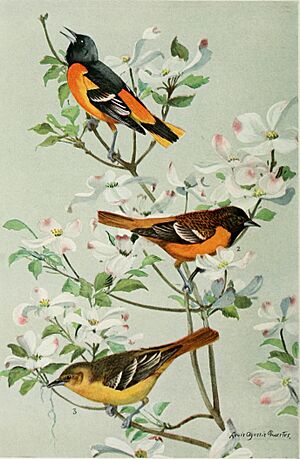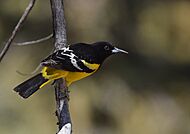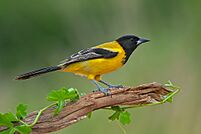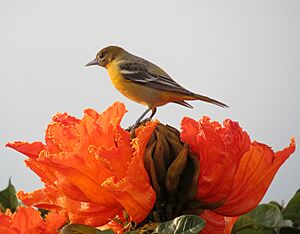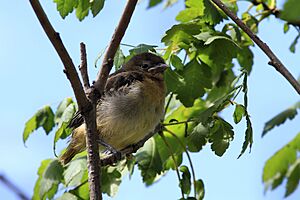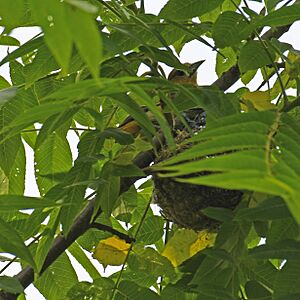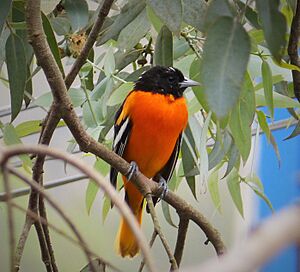Baltimore oriole facts for kids
Quick facts for kids Baltimore oriole |
|
|---|---|
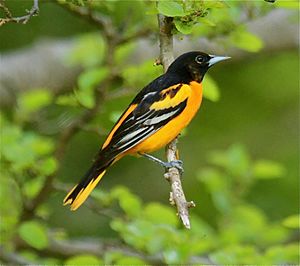 |
|
| Adult male | |
| Conservation status | |
| Scientific classification | |
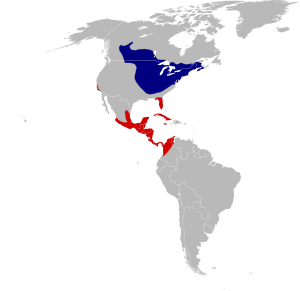 |
|
| Range of I. galbula Breeding range Wintering range Note: range in Venezuela, Hispaniola, Puerto Rico, and the rest of the Caribbean not shown | |
| Synonyms | |
|
The Baltimore oriole (Icterus galbula) is a small, colorful bird found in eastern North America. It's known for its bright orange and black feathers, especially on the male birds. Its name comes from the colors of the 17th-century Lord Baltimore's family crest, which looked like the bird's feathers.
For a while, the Baltimore oriole and another bird called the Bullock's oriole were thought to be the same species. They were called the "northern oriole." But after more research, scientists realized they were different species after all.
The Baltimore oriole is the official state bird of Maryland. It's also the name and mascot for the Baltimore Orioles baseball team!
Contents
About the Baltimore Oriole
Naming the Bird
The Baltimore oriole got its scientific name, Coracias galbula, in 1758 from a Swedish scientist named Carl Linnaeus. He based his description on drawings and notes from an English naturalist, Mark Catesby.
The word "Oriole" comes from a Latin word meaning "golden." The scientific name Icterus comes from an ancient Greek word for a yellow bird. The word galbula is also a Latin name for a yellow bird. All these names highlight the bird's bright, golden-orange colors!
What Does a Baltimore Oriole Look Like?
This bird is about 17 to 22 centimeters (7 to 9 inches) long. Its wings can spread out from 23 to 32 centimeters (9 to 12.5 inches). They have a strong body, a long tail, fairly long legs, and a thick, pointed beak. An average Baltimore oriole weighs about 34 grams (1.2 ounces). Male orioles are usually a little bigger than females. Both male and female adult orioles have white bars on their wings.
Adult male orioles are bright orange on their belly, shoulders, and lower back. The rest of their feathers are black. Some males are a very deep orange, while others are more yellowish-orange.
Adult female orioles are yellowish-brown on their upper parts with darker wings. Their chest and belly are a dull orange-yellow. Young orioles look similar to the females. Male orioles don't get their full adult colors until the fall of their second year.
Where Do They Live?
Baltimore orioles spend their summers in North America. This includes parts of Canada and the eastern United States, stretching south to states like Mississippi, Alabama, and Georgia.
When winter comes, they fly south to warmer places like Central America and northern South America. Some might even stay in the southern United States if there's enough food for them.
These birds like to live high up in large, leafy trees. They don't usually live in deep forests. You can often find them in open woodlands, along the edges of forests, or near rivers. They are very good at adapting to different places. Lately, they are often seen in orchards, farms, city parks, and even suburban areas, as long as there are some trees.
Sadly, the number of Baltimore orioles has been going down in some areas. One reason for this is a disease called Dutch elm disease, which has destroyed many elm trees. Elm trees were a favorite nesting spot for these birds.
Baltimore Oriole Behavior
Song and Calls
Baltimore orioles have a beautiful song! It's a series of sweet whistles that sound like "tyew, pyeer, peededoo, and "teer." They also make other sounds, like a nasal "veeer, a low chatter, and high calls like "tyew-li and kleek."
Male orioles sing to claim their territory and to attract a mate. Sometimes, during breeding season, male orioles will make a "flutter-drum sound" with their wings while flying. Female orioles also sing to communicate. When protecting her nest, a female might make a fierce screeching sound. Both male and female orioles make warning calls that sound like a noisy chatter if they feel threatened. Other orioles nearby will often respond to these calls to help defend the area.
Reproduction and Life Cycle
Outside of mating season, Baltimore orioles usually live alone. They typically have one mate for the breeding season. In spring, males find a territory and try to attract females by singing and chattering. They also do a "bow display," where they bow with their wings lowered and tail fanned out. Females might ignore these displays or respond by singing or fluttering their wings.
The female Baltimore oriole builds the nest. It's a very strong, pouch-like nest that hangs from the end of a tree branch. She uses fine plant materials or animal hair to weave it tightly. They often choose trees like elm, cottonwood, maple, willow, or apple trees. The nest is usually about 7 to 9 meters (23 to 30 feet) above the ground.
The female lays three to seven eggs, but usually about four. The eggs are pale gray to bluish-white and are about 2.3 x 1.6 centimeters (0.9 x 0.6 inches) in size. The eggs hatch after 12 to 14 days. Once the baby birds hatch, both parents feed them by bringing up food from their stomachs. The female also keeps the young warm for two weeks. After that, the young birds start to fly and become independent soon after. If the nest or eggs are destroyed, the oriole usually doesn't lay another set of eggs that year.
Dangers and Lifespan
Many things can be dangerous for Baltimore orioles, including their eggs, young, and adult birds. Common animals that might try to get to their nests include common grackles, American crows, blue jays, black-billed magpies, tree squirrels, and domestic cats. Cats often catch young orioles that have just learned to fly or adult birds that are sitting on their nests.
Birds of prey, like eastern screech owls, Cooper's hawks, and sharp-shinned hawks, often hunt orioles. Larger birds like peregrine falcons and great horned owls might also catch them sometimes.
The oldest Baltimore oriole found in the wild lived to be 11 years and 7 months old. In captivity (like in a zoo), they have been known to live up to 14 years.
What Do They Eat?
Baltimore orioles look for food in trees and bushes. They also make short flights to catch insects. They are very agile and can climb, hover, and hang upside down among leaves and branches to find food.
They mostly eat insects, berries, and nectar. You might even see them drinking from hummingbird feeders! One of their favorite foods is the forest tent caterpillar moth when it's still a larva (caterpillar). These caterpillars can cause a lot of damage to trees, so orioles help control their numbers. The orioles will beat the caterpillar against a branch to remove its protective hairs before eating it. They also eat beetles, grasshoppers, wasps, and spiders.
Unlike some other fruit-eating birds, Baltimore orioles prefer only ripe, dark-colored fruit. They will look for the darkest mulberries, the reddest cherries, and the deepest-purple grapes. They won't eat green grapes or yellow cherries, even if they are ripe.
Baltimore orioles sometimes use a special trick with their beaks called "gaping." They stab their closed beak into soft fruits, then open it up to drink the juice with their tongues. In spring and fall, sugary foods like nectar and fruit help them build up fat, which gives them energy for their long migration flights.
Many people now attract Baltimore orioles to their backyards with special feeders. These feeders often have the same sweet liquid as hummingbird feeders, but they are orange instead of red and have bigger perches for the orioles. Baltimore orioles also love halved oranges and grape jelly. If they find a good feeder, they will even bring their young birds there!
See also
 In Spanish: Oropéndola de Baltimore para niños
In Spanish: Oropéndola de Baltimore para niños
Images for kids



